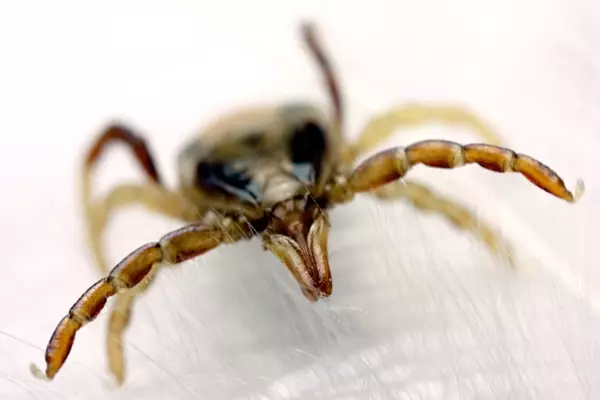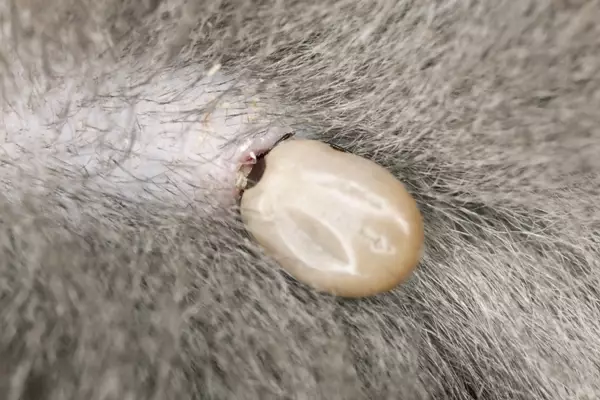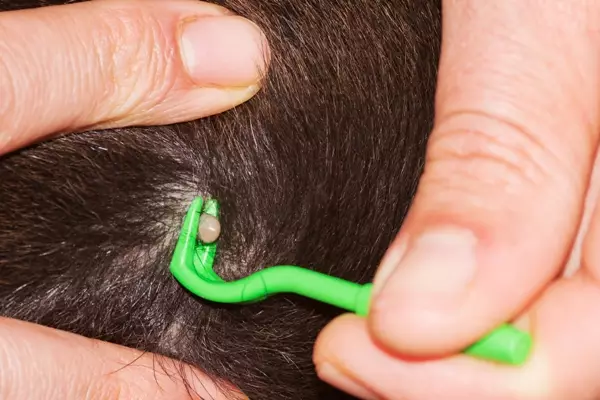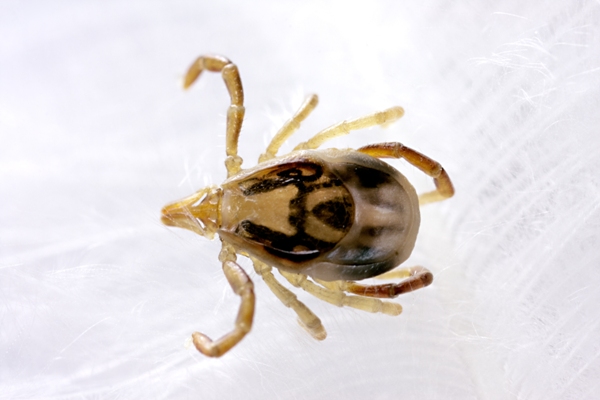Paralysis tick in dogs and cats
What is tick paralysis?
The paralysis tick, also known as the Ixodes Holocyclusis, is the only tick species that poses a real threat to Australian pets. Found on the east coast of Australia, this tick usually targets native wildlife such as bandicoots, possums and koalas. However, they have a tendency to attach themselves to domesticated animals, and sometimes even to humans.

Pets are much more likely to pick up a paralysis tick if they are outdoor animals, interact with wildlife or have access to bushy or grassy areas. Not surprisingly, paralysis ticks are more likely to be found affixed to dogs than cats, but outdoor cats are also susceptible. There has been an increased number of these ticks in recent years, which some scientists have attributed to global warming, as well as the growing bandicoot population.
The paralysis tick injects a poison into the dog or cat as it feeds, causing weakness, irritation, a change in pitch in the meow or bark, wobbliness and excessive panting. Tick Paralysis or ‘toxicity’ occurs when over a period of time ticks cause single organ toxicity, targeting the cardiac system, bladder or lungs, and can lead to severe paralysis.
The female paralysis tick is the more dangerous. She lays up to 3,000 eggs and, once hatched, the offspring attach themselves to vegetation with their first host in their sights. After finding their first host – usually a possum, bandicoot or koala – the ticks drop off and wait for another host, and this time, a cat or dog, even a human is usually the host of choice. These tiny parasites will engorge themselves with blood over a hundred times their body weight and can grow to the size of your little finger nail.
Paralysis ticks, although dangerous – especially to small pets – can be combatted with a number of medications and preventative measures.
Tick paralysis prevalence in Australia

The highest prevalence of tick paralysis occurs in the coastal areas of Eastern Australia. When divided by state, New South Wales had the highest prevalence of tick paralysis cases in 2021 (63.5%), followed by Queensland (32.6%), according to Petsure claims data.
Cost of tick paralysis in dogs
Average claim cost* |
Highest claim cost* |
No of dogs affected in 2022 |
| $2,402 | $53,331 | 664 |
Cost of tick paralysis in cats
Average claim cost* |
Highest claim cost* |
No of cats affected in 2022 |
| $1,859 | $20,348 | 119 |
*Based on PetSure claims data, 2022 calendar year. Reimbursement for these claims under a pet insurance policy, would be subject to limits, such as annual benefit limits or sub-limits, benefit percentage, applicable waiting periods and any applicable excess. Cover is subject to the policy terms and conditions. You should consider the relevant Product Disclosure Statement or policy wording available from the relevant provider. Please note that values calculated are based on all claims for that condition and medically related conditions in each calendar year.
Tick paralysis affects thousands of pets in Australia each year, and as you can see from the figures above, treatment can be very costly. Bow Wow Meow’s Nose-to-Tail Cover includes treatment for Tick Paralysis with no sub-limits. Read more here.
Symptoms of paralysis tick in dogs and cats
Paralysis ticks effectively poison your pet. Fortunately, there are a number of symptoms that can raise the alarm when it comes to identifying Tick Paralysis. Most often, you will notice a change in behaviour and the physical fitness of your cat or dog. They will most likely become sickly and weak and their voice may even change.
It’s essential that if symptoms are observed, medical attention is immediately sought. Some pets have been known to die from Tick Paralysis, especially puppies, kittens and the smaller breeds.
Some of the symptoms to look out for include:
- While most dogs and cats will vomit from time to time, if you notice that yours is vomiting more than a couple of times a day, they could be suffering from Tick Paralysis. Look out also for frothy vomit as this can be another symptom.
- If your pet is a little unsteady or wobbly in the legs, it could be a sign of Tick Paralysis.
- If your cat is showing the above symptoms and she is meowing more than usual, Tick Paralysis could be the cause. A change in the bark or meow, for example, the pitch or volume is noticeably different, could also point to a tick.
- Dogs will often pant heavily if they are affected by a paralysis tick. Listen for loud breathing and coughing.
- If the poisoning progresses, paralysis sets in and after a time the animal is not be able to move. The gums will turn blue and breathing will become increasingly laboured. If not treated quickly, at this stage death will usually follow.
Most of these symptoms are very serious and if not caused by Tick Paralysis, are associated with another form of poisoning or serious, often life-threatening condition. If you observe any of the above behaviours in your cat or dog, seek immediate assistance from your veterinarian.
Unsure how serious it is?
Bow Wow Meow policyholders can get access to trusted vet care anytime, anywhere, at no additional cost. Connect to an experienced Australian registered vet via video call, 24/7. Whether it’s providing vet advice, setting up at-home treatment plans, or confirming if you need to visit a vet in person, you can get help when you need it.
Find out more about our pet insurance cover options.
Diagnosis of paralysis tick in dogs and cats
Paralysis tick season Australia occurs between the months of August and February, when the numbers typically increase with wet weather and the warm, humid days that follow. Tick Paralysis is high on the veterinary diagnoses list on the east coast during this period.
Tick Paralysis is usually diagnosed by observing the symptoms described above. Upon careful examination, the veterinarian may observe one or more ticks affixed to your pet or, if the tick is no longer present, the inflamed crater-like area that it has left behind.
Sometimes it’s difficult for the vet to pinpoint the location of the culprit. Paralysis ticks can attach themselves deep inside your pet’s ears, anus or in between the toes. If no ticks are located, diagnosis of Tick Paralysis can be made by observing symptoms and by ruling out poisoning and other diseases that could be impairing the animal’s stability.
The vet may take a blood sample to test for changes to the levels of glucose and cholesterol and a decrease in potassium level. The dog or cat’s pulse can also provide an indication of physical stress. Another – and much more conclusive – test is blood gas analysis. This test is risky, however, and the pros and cons should be discussed with your vet before proceeding.

Treatment and management of paralysis tick in dogs and cats
With the rise of cases in recent years, the treatments for paralysis ticks have become increasingly sophisticated. For veterinarians on the east coast of Australia, treatment for Tick Paralysis has become a common procedure. Paralysis ticks can prove fatal to smaller or older pets, so while the steps involved can be stressful for the animal, they are necessary in order to save it from further illness, paralysis and death.
Your pet will need a thorough investigation over its entire body so that all ticks can be removed. Sedatives will usually be given to cats as this process can be quite stressful to them. Pets will be given a premedication and an anti-tick serum to counter the effects of the tick venom. Some animals can have allergic reactions to the medication, so careful monitoring will follow.
It’s important that a period of rest follows the procedure. During this time, breathing will be monitored and the function of the bladder will be observed to ensure that it is operating properly. In the more severe and advanced cases of Tick Paralysis, a drip and oxygen will be required. Blood tests will sometimes follow the procedure to ensure your pet’s health and recovery from the toxins.

Prevention of paralysis tick in dogs and cats
Paralysis ticks are sneaky parasites that wait in bushy or grassy vegetation until your pet passes through it. The only way to avoid them is to keep your pet indoors or away from grassy areas. The east coast of Australia is a haven for the paralysis tick, even in the suburbs of Sydney.
If you suspect your pet may have picked up a Paralysis tick, there are a few things you can do to avoid Tick Paralysis from potentially setting in. It’s a good idea to get into the habit of checking for ticks after walks or outdoor activity anyway, especially during the warmer months, by doing the following:
- Systematically work your way through your pet’s coat with your fingertips, feeling for unusual lumps, bumps or sores.
- Be sure to check in the folds of the neck and underneath the collar.
- Check the other popular spots for these sneaky suckers – between the toes, behind and in the ears, and even in the anus.
- Check your pets thoroughly after they’ve spent time outdoors or in the bush; and especially if you’ve taken them camping for a few days.
- If you find a tick, don’t stop there. Unfortunately, if you’ve found the one, there’s likely to be a whole lot more.
Tick preventitives are essential all year round
Tick preventatives are not just for the summer time, but are required throughout the year, as evidenced by tick paralysis claims data.
With rising global temperatures, the peak period for tick paralysis claims has changed. These nasty creatures are becoming active earlier and staying around for longer.
- In 2000, the peak period was from September to December.
- In 2023, the peak period was from August to January.
Tick control and regular manual checking of the fur for ticks are essential to protect your pet from paralysis ticks. Our Routine Care (non-insurance benefit) provides a contribution towards everyday items such as vaccinations and flea, tick and worm treatments. Get an online quote now.
Commonly affected breeds
Any breed of dog or cat can become the host of a paralysis tick. There are, however, a number of breeds that seem more susceptible to the ticks than others. Try to keep these breeds away from bushy areas and make sure to check them for ticks regularly:
- Old English Sheepdogs
- Collies
- Border Collies
- German Shepherds
- Irish Setters

Interesting facts
- While the paralysis tick, AKA Ixodes Holocyclusis, sucks the blood of its host to live, it poisons the host in the process. The poison attacks the nervous system, eventually causing complete paralysis and, in extreme cases, death.
- Ixodes Holocyclusis is native to a relatively small section of the country. Abundant during spring and summer, the paralysis tick is only found on the east coast of the country and is highly common on Sydney’s Northern Beaches.
- Symptoms aren’t immediate – you’ll usually start to see signs of Tick Paralysis some three to five days after it attaches itself to your pet. Around this time, staggering, wobbliness and vomiting will begin.
- In their early stages, the Ixodes Holocyclusis will only be the size of a pinhead or smaller, but they don’t stay that tiny for long. After gorging itself on blood, it can grow to 100 times its own bodyweight. In the adult stage, a paralysis tick can be the size of a little finger nail, and even reach the size of a thumbnail.
Bow Wow Meow Pet Insurance can help protect you and your dog should an unexpected trip to the vet occur.
-
Find out more about our dog insurance options
-
Get an online pet insurance quote
Bow Wow Meow is proud to have been awarded winner of Canstar’s ‘Most Satisfied Customers’ Award in the Pet Insurance category for both 2024 and 2025!
Bow Wow Meow is proud to have been chosen as Product Review’s Pet Insurance Award Winner every year from 2018 to 2025! This is based on 2,995 independent customer reviews (as at 21/01/2025), with an overall rating of 4.3*
Google Review rating = 4.5* (based on 968 reviews)
Trust Pilot rating = 4.6* (based on 531 reviews)
Bow Wow Meow is proud to have been chosen as Product Review’s Pet Insurance Award Winner every year from 2018 to 2025! This is based on 2,995 independent customer reviews (as at 21/01/2025), with an overall rating of 4.3*
Google Review rating = 4.5* (based on 968 reviews)
Trust Pilot rating = 4.6* (based on 531 reviews)
Bow Wow Meow has been chosen as a winner in the Finder Pet Insurance Awards 2024. Finder’s panel of experts analysed over 140 quotes to award our Ultimate Care Plan the winner of the “Pet Insurance – Value” category.
More information
https://www.petmd.com/dog/conditions/infectious-parasitic/c_dg_tick_paralysis
http://www.greenhounds.com.au/Uploads/File/Paralysis%20Tick.pdf








